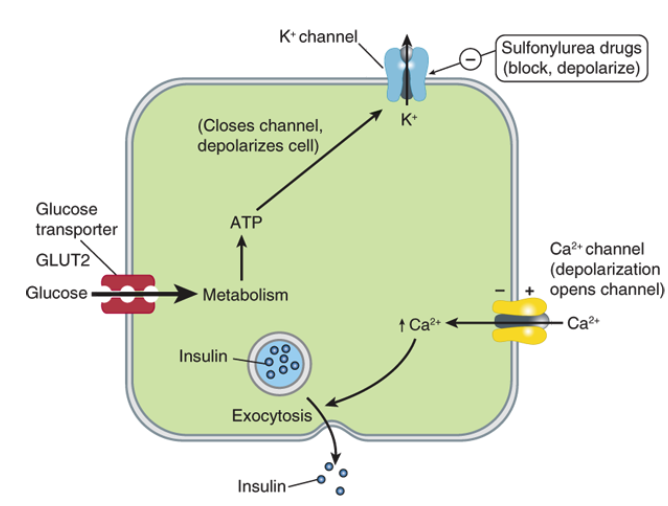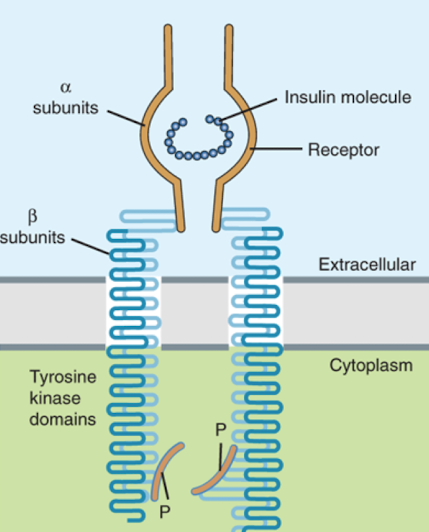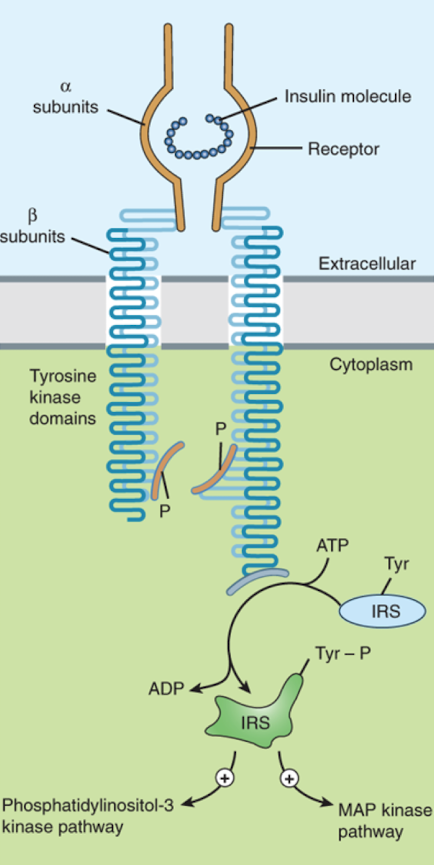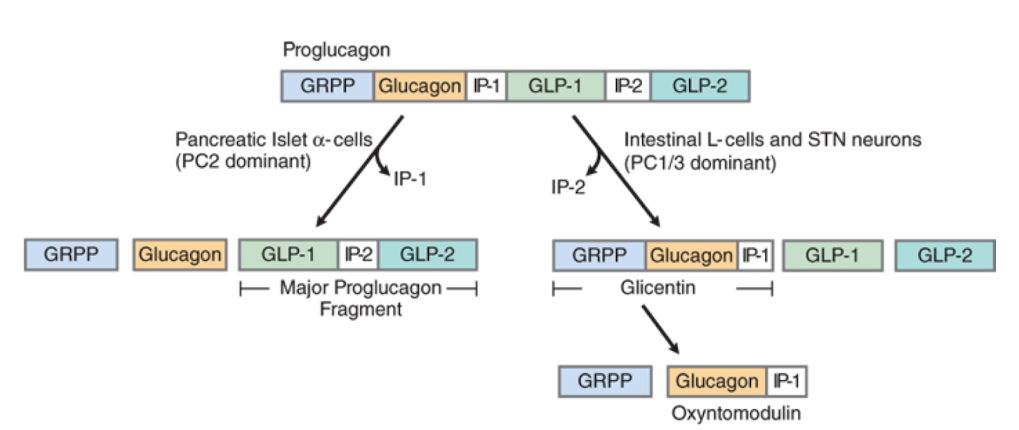Diabetes - Pharmacology
1/53
There's no tags or description
Looks like no tags are added yet.
Name | Mastery | Learn | Test | Matching | Spaced |
|---|
No study sessions yet.
54 Terms
Which organ does glucagon primarily work on?
The liver
What stimulates insulin release in the fed state?
increasing blood sugar
presence of food in intestines
other nutrients
Function of epinephrine in glucose homeostasis
promotes glycogenolysis
promotes gluconeogenesis
inhibits glucose utilization
promotes lipolysis
Function of cortisol in glucose homeostasis
Promotes gluconeogenesis
Function of growth hormone in glucose homeostasis
Decreases peripheral glucose utilization
Explain the synthesis of endogenous insulin
pancreatic B-cells synthesize pre-pro-insulin
removal of SP domain = pro-insulin
3 disulfide bridges form and c-peptide is removed
result is insulin (51 amino acids and A & B chains linked by disulfide bonds)

What is the primary regulator of insulin secretion?
Glucose
Explain how insulin is secreted from a beta cell
beta-cell is hyperpolarized in resting state with insulin in vesicles
glucose enters cell through glucose transporters
glucose is metabolized in the cell, which increases ATP production
more ATP leads to closing of ATP-sensitive K+ channel
less K+ leaves the cell, so membrane becomes depolarized
depolarization opens voltage-gated Ca2+ channels
Ca2+ enters cell, leads to exocytosis of insulin-filled vesicles

What is the primary effect of insulin at target tissues?
Stimulates uptake of glucose in these tissues
What are the cellular effects caused by insulin when it binds an insulin receptor?
changes in substrate and ion transport
regulation of protein and enzyme activity
translocation of proteins
changes in gene transcription
activation of growth and differentiation-promoting pathways
What type of receptor is the insulin receptor?
Similar to tyrosine-kinase receptor, but receptor is composed of two subunits (alpha and beta)

How does the insulin receptor change upon binding insulin?
Binding of insulin to alpha subunit brings the beta subunits together (they dimerize)
Which part of the insulin receptor has tyrosine kinase activity?
The beta subunits (they phosphorylate each other, resulting in activation of several other proteins)

What is the half-life of endogenous insulin?
5-9 minutes
What is the key metabolic step in insulin breakdown?
Breakage of disulfide bonds by insulinase (glutathione insulin transhydrogenase)
Where can insulin be metabolized?
liver
kidneys
muscle
How much insulin metabolism occurs in the kidneys?
Only ~20%, so don’t need to renally adjust!
How does SC injection of insulin differ from pancreatic release?
In SC:
rise and fall of insulin is slower (takes time for absorption)
additional sources of variability (injection site, type of insulin)
How long before a meal does someone need to inject insulin if they are using regular insulin?
~30 minutes before meal (takes 30-45 min for onset)
Why is insulin absorption slow when injected SC?
In solution, insulin forms a hexamer which must dissociate before the monomers can be absorbed into systemic circulation
How is the rate of hexamer dissociation changed?
By modifying the amino acid sequence of regular insulin
True or false. Regular insulin has the same AA sequence as endogenous insulin.
True
Can regular insulin be administered via IV?
Yes
What changes to AA are made in insulin lispro?
Lysine at position 29 is swapper with proline at position 28
What changes to AA are made in insulin aspart?
Proline at position 28 is replaced by an aspartate
What is the structural difference between rapid-acting insulin aspart and Fiasp?
Fiasp has nicotinamide
What changes to AA are made in insulin glulisine?
Lysine at position 29 is replaced by a glutamate and the asparagine at position 3 is replaced by lysine
Why is insulin NPH cloudy?
Regular insulin complexes with NPH and zinc
Why is the absorption of NPH slower than regular insulin?
Proteases are needed to degrade the protamine before absorption, so peak is delayed and the duration is prolonged
What changes to AA are made in insulin detemir?
Threonine at position 30 is deleted and lysine at position 29 is myristoylated to increase aggregation and albumin binding
(myristoylated = addition of larger fatty molecule)
How is insulin detemir released slowly over time?
Albumin-bound insulin forms a depot that is slowly released and able to distribute to target tissues
What changes to AA are made in insulin glargine?
Two arginine residues are added to the B chain and asparagine at position 21 on the A chain is replaced by glycine
What do the AA changes for insulin glargine lead to?
Result in an increased solubility at acidic pH
(soluble in solution (acidic) but precipitates in body to form a depot that is slowly re-solubilized and absorbed)
Which insulin cannot be mixed with other types?
Insulin glargine (will precipitate at normal solution pH)
What changes to AA are made in insulin degludec?
Threonine at B30 is deleted and hexadecanedioic is added to the lysine at B29 via y-L-glutamyl spacer
Why does insulin degludec have such a prolonged effect?
Forms a multihexameric complex that dissociates slower than regular insulin and also binds to albumin
(different from glargine and detemir)
Why is insulin icodec able to be dosed once weekly?
Has strong, reversible binding to albumin which delays SC absorption
Has additional AA substitutions that increase resistance to degradation
What is the biosimilar of Lantus?
Basaglar
What is the biosimilar of Humalog?
Admelog
Why is insulin NPH used less often now?
Had a higher incidence of allergic reactions
Signs and sx of nocturnal hypoglycemia
nightmares
restless sleep
profuse sweating
morning headache
morning “hangover”
could also be asymptomatic
What is a risk of glucagon tx?
Overshooting and causing a spike in glucose
What causes the allergic reactions that are seen with insulin?
The antigens are protein contaminants, not the insulin itself
Do auto-insulin antibodies that are developed cause issues with insulin treatment?
They are not associated with therapeutic resistance
What is glucagon derived from?
Proglucagon (precursor protein)

What kind of receptor is the glucagon receptor?
GPCR (coupled G alphas)
What does glucagon promote?
glycogenolysis
gluconeogenesis
ketogenesis
What is glucagon used for clinically?
hypoglycemia tx
reversal of beta blocker overdose
bowel radiology